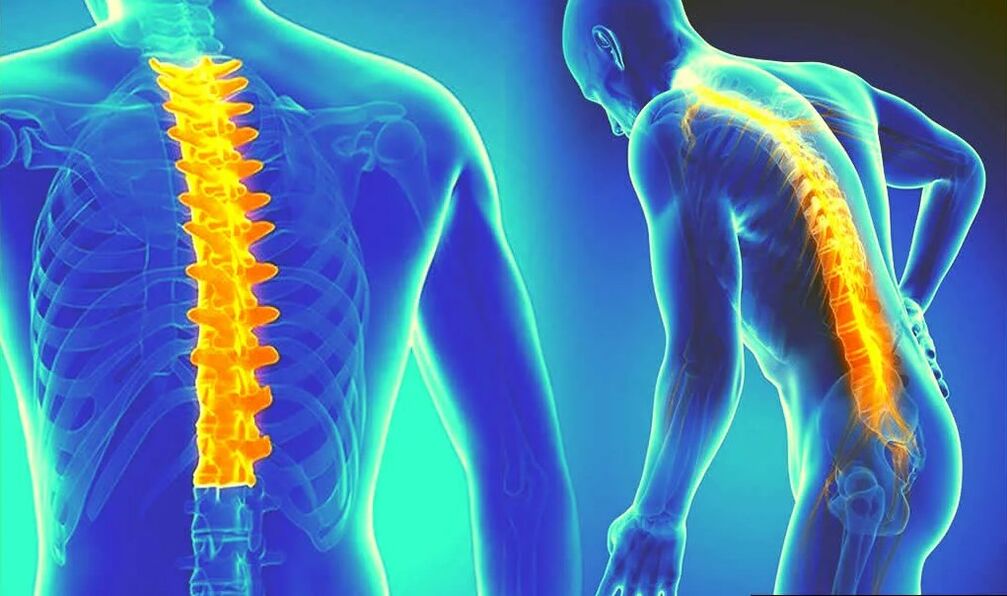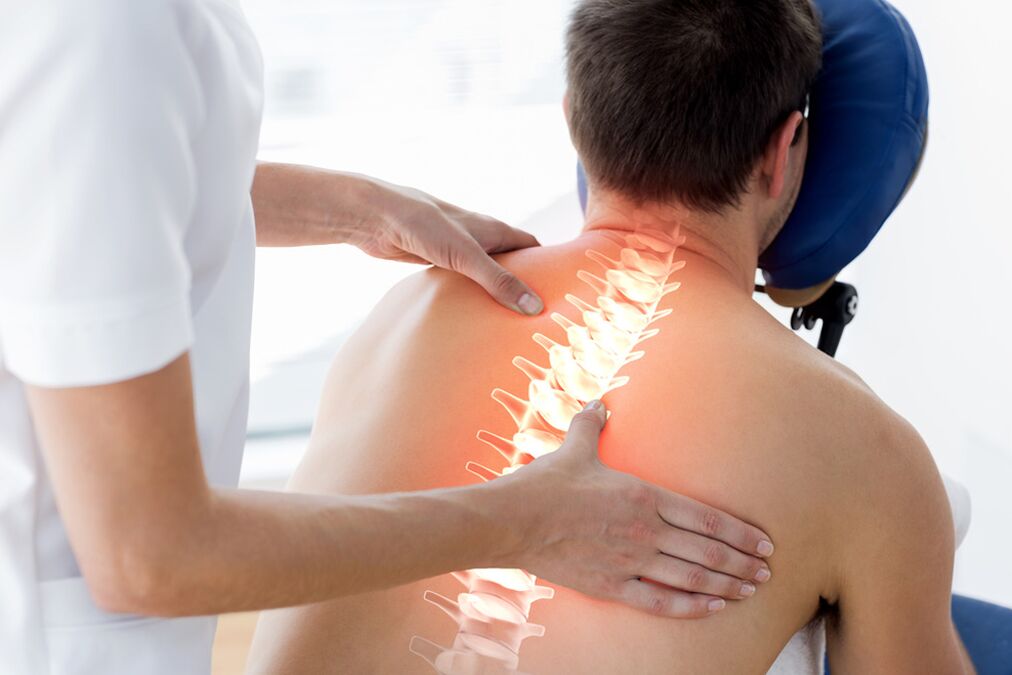Osteochondrosis is a pathological process in the cartilage of the intervertebral discs and nearby tissues. The disease can occur in any part of the spine, however, the cervical spine is more susceptible to osteochondrosis. This is due to the anatomical features of the body. The vertebrae in the neck are smaller than the chest and lumbar regions and are very close to each other. In addition, the neck is characterized by increased mobility and is subjected to regular stress while holding the head.

Why does the disease appear?
The development of the disease is primarily associated with age-related changes. Other reasons include:
- lack of physical activity;
- spinal diseases;
- excessive load;
- incorrect posture;
- unfavorable heredity;
- increased body weight;
- autoimmune diseases in which cartilage is damaged.
The condition of bone and cartilage tissue is severely affected by malnutrition. A diet with a deficiency of calcium, phosphorus, zinc, magnesium, vitamins A and E, vitamin D contributes to the pathological development. The high-risk group includes office workers, professional athletes, and people engaged in heavy physical labor.
How cervical osteochondrosis is diagnosed
The symptoms of the disease depend on the clinical condition and stage of development. The most common symptoms:
- pain that affects not only the neck and head, but also other parts of the body;
- weakness, decreased sensitivity of the hands, numbness of the face;
- a crisis in the neck when you need to turn your head;
- dizziness, weakness, darkening of the eyes due to constriction of blood vessels;
- deterioration of vision and hearing.
Pain in osteochondrosis of the cervical spine worries almost all patients. Pathologically, the blood vessels in the neck area, the nerve endings constrict. As a rule, the pain is most often felt in the head, occiput, shoulder area and spreads to the scapula and chest.
Against the background of the disease, the heart rhythm may be disturbed. There are several blood vessels in the neck that are responsible for supplying blood to the brain. When the blood vessels constrict, the patient faces problems such as loss of coordination, arrhythmias and coronary heart disease. In severe cases, circulatory blockage can lead to strokes and other life-threatening conditions.
Stages of the disease
The development of the disease is divided into four stages:
- In the early stages, bone and cartilage tissue begin to break down again. The pathology manifests itself as a small pain and fatigue that patients associate with stress.
- In the second stage, there is a decrease in the disk, the appearance of cracks. The pain increases, there may be numbness on the face and the sensitivity of the limbs decreases.
- In the third stage, an intervertebral hernia begins to form. The process affects the muscles and blood vessels. The patient experiences not only pain but also dizziness.
- In the final stage, bone tissue grows and nerve endings are compressed. The disease manifests itself with obvious symptoms: pain, dizziness, numbness. Many patients have impaired motor function.
Diagnostics
If you suspect cervical osteochondrosis, the patient should consult a neurologist and make a diagnosis. The task is to assess the condition of bone and cartilage tissue. Previously, X-rays were used to diagnose diseases of the spine. More advanced research methods are now preferred:
- CT examination;
- MRI;
- duplex scanning of cervical lumbar vessels.
Often a doctor will make a comprehensive diagnosis. It allows you to determine the presence and location of hernias, the speed of blood flow, the presence of obstacles to normal blood circulation.
Treatment
A patient diagnosed with cervical spine osteochondrosis needs to reconsider his lifestyle, exercise regularly, and eat properly. To improve the condition, it is recommended to sleep on an orthopedic mattress and a comfortable pillow to reduce stress from the spine.
Medications
Patients with cervical osteochondrosis are prescribed drugs that eliminate inflammation, improve blood flow and reduce pain. The doctor prescribes drugs for vasodilatation, muscle relaxants, non-steroidal anti-inflammatory drugs, drugs to improve cerebral circulation, chondroprotectors - a means to restore cartilage tissue. The body needs B vitamins, calcium, phosphorus, magnesium, niacin to slow down the decay of bone tissue.
Physiotherapy

Physiotherapy is the main method of treatment of cervical spine osteochondrosis. Experts use many procedures whose task is to improve metabolic processes in bone and cartilage tissues, reduce pain, relieve spasms and improve blood circulation. Here are the basic techniques:
- Shock wave therapy. . . Low-frequency acoustic waves affect the cartilage tissue of the cervical spine. Helps regenerate tissues, slows down the formation of osteophytes - growths in the bones that constrict nerve endings and blood vessels. The source of low-frequency waves is a special device, so the course of SWT can be conducted only in one medical institution.
- Massage. . . This is the most common method of conservative therapy for cervical osteochondrosis. Massage helps to improve blood circulation and relieve muscle spasms. The method of therapeutic massage is chosen depending on the stage of the disease and its clinical manifestations. This is a very important condition, because if the massage is performed unprofessionally, it can harm the patient and lead to deterioration of well-being. Vascular diseases, high blood pressure is worth giving up massage. During exacerbation, the massage should be as sensitive as possible. It is allowed to rub, rub, that is, it affects the upper layers of tissues.
- Therapeutic gymnastics (exercise therapy). . . Sports therapy helps to strengthen muscles and improve blood circulation. Special training kits are available for patients with osteochondrosis. Gymnastics can be done not only in the office of a medical institution, but also at home. As a rule, exercise therapy is most effective in remission when the patient does not feel severe pain. Wellness exercises should be combined with walks, water procedures.
- Acupuncture. . . This is an adjunctive method for the treatment of osteochondrosis based on the effect of special needles on biologically active points. Due to this, the metabolism is activated, the pain syndrome is reduced.
- Kinesitherapy. . . This is a technique used to treat diseases of the spine, rehabilitation after injury. Exercise removes load from the spine, improves mobility and restores blood circulation. Kinesitherapy classes are conducted under the guidance of an instructor. There are many methods and devices for training, so a suitable set of exercises is selected for each patient.
- Laser therapy. . . Thanks to the laser beam, a positive effect is achieved, the patient's well-being improves. The procedure reduces inflammation and pain and has a positive effect on metabolic processes.
- Electrotherapy. . . Specialists use devices with galvanic, pulsed, alternating current sources. The purpose of the procedure is to reduce pain, relieve spasms and stimulate.
- Water procedures. . . Water is the best medicine for osteochondrosis. Patients with this disease are shown therapeutic baths, swimming, underwater massage. It is a regular visit to a pool, which is very useful for the prevention and treatment of pathology.
Surgery for osteochondrosis
Spinal surgery for osteochondrosis is indicated for patients with an advanced stage of the disease in which remission cannot be achieved by conservative methods. Surgery is used to remove herniated discs and affected discs. In addition, operations are performed to expand the diameter of the spinal canal and remove the spinal arch. Their goal is to relieve the constriction of the nerves and spinal cord, which allows you to get rid of anxiety.
All manipulations are performed under X-ray and microsurgery under anesthesia.
The method of laser discectomy is used for disc protrusion. This is a minimally invasive technique that uses a laser beam to evaporate the nuclear pulp of the disc and thus eliminate compression.
Nutrition for osteochondrosis
Malnutrition increases the risk of developing degenerative-dystrophic diseases of the musculoskeletal system, including osteochondrosis. To slow down the pathological processes in the bones and cartilage, it is necessary to provide the body with sufficient amounts of vitamins and minerals. The diet should include:
- dairy products - a source of calcium;
- fresh vegetables and herbs;
- legumes, nuts, seeds - a source of protein, magnesium, B vitamins;
- cereals, baked goods with whole grains;
- lean meat;
- Fish and seafood;
- olive and other vegetable oils;
- jelly, mixed meat, mixed dishes.
There are no strict dietary restrictions, but there are foods that are undesirable to consume in large quantities. First of all, it is a strong tea and coffee that impairs the absorption of calcium and vitamins. High-salt foods are also not good.























